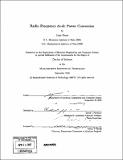| dc.contributor.advisor | David J. Perreault. | en_US |
| dc.contributor.author | Rivas, Juan, 1976- | en_US |
| dc.contributor.other | Massachusetts Institute of Technology. Dept. of Electrical Engineering and Computer Science. | en_US |
| dc.date.accessioned | 2007-08-29T20:45:32Z | |
| dc.date.available | 2007-08-29T20:45:32Z | |
| dc.date.copyright | 2006 | en_US |
| dc.date.issued | 2007 | en_US |
| dc.identifier.uri | http://hdl.handle.net/1721.1/38691 | |
| dc.description | Thesis (Sc. D.)--Massachusetts Institute of Technology, Dept. of Electrical Engineering and Computer Science, February 2007. | en_US |
| dc.description | Includes bibliographical references (p. 197-204). | en_US |
| dc.description.abstract | THIS THESIS addresses the development of system architectures and circuit topologies for dc-dc power conversion at very high frequencies. The systems architectures that are developed are structured to overcome limitations associated with conventional designs. In particular, the new architectures described here structure the energy processing and control functions of the system in such a manner that high efficiency can be achieved across wide load range while regulating the output. Moreover, these architectures are amenable to circuit designs operating at fixed frequency and duty ratio, considerable easing the circuit design. The thesis also develops new circuit designs that are well suited to these new architectures. As part of this, two new gate drives and control methods are introduced that greatly reduce gating loss at VHF frequencies for fixed frequency, fixed duty ratio operation. One of these gating schemes provides near theoretical minimum loss by resonantly wave shaping the gate voltage to have a trapezoidal drive voltage. This waveshaping approach is then taken a step further, yielding a new class of dc-dc converter that archives a significant reduction in peak switch voltage stress, requires small passive components with low energy storage, and provides the capability for extremely rapid startup and shutdown. This new class of converter is well adapted to the architectures and gate drive methods proposed in the thesis. It is expected that the new architectures and circuit designs introduced here will contribute to the development of power converter having greatly reduced size and improved transient performance. | en_US |
| dc.description.statementofresponsibility | by Juan Rivas. | en_US |
| dc.format.extent | 204 p. | en_US |
| dc.language.iso | eng | en_US |
| dc.publisher | Massachusetts Institute of Technology | en_US |
| dc.rights | M.I.T. theses are protected by copyright. They may be viewed from this source for any purpose, but reproduction or distribution in any format is prohibited without written permission. See provided URL for inquiries about permission. | en_US |
| dc.rights.uri | http://dspace.mit.edu/handle/1721.1/7582 | |
| dc.subject | Electrical Engineering and Computer Science. | en_US |
| dc.title | Radio frequency dc-dc power conversion | en_US |
| dc.title.alternative | Radio frequency direct current-direct current power conversion | en_US |
| dc.type | Thesis | en_US |
| dc.description.degree | Sc.D. | en_US |
| dc.contributor.department | Massachusetts Institute of Technology. Department of Electrical Engineering and Computer Science | |
| dc.identifier.oclc | 164907065 | en_US |
